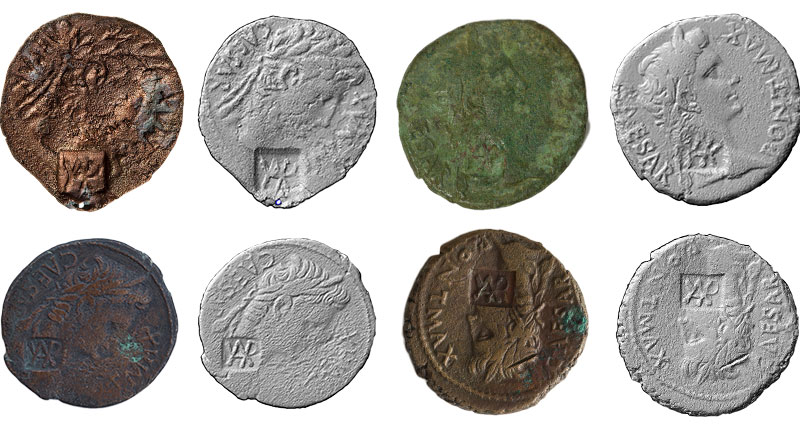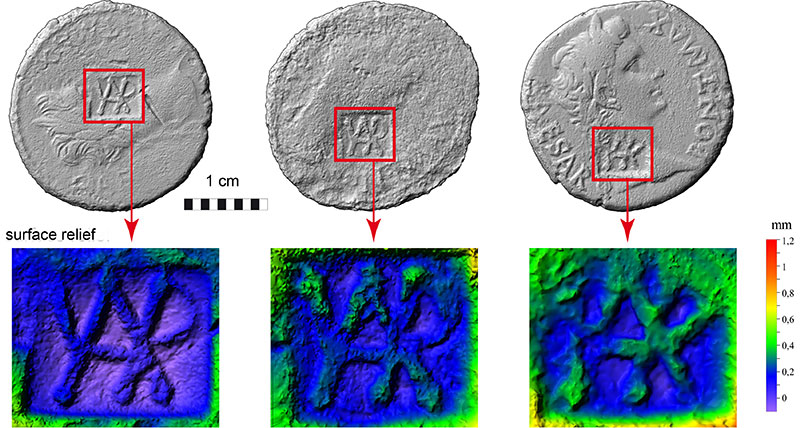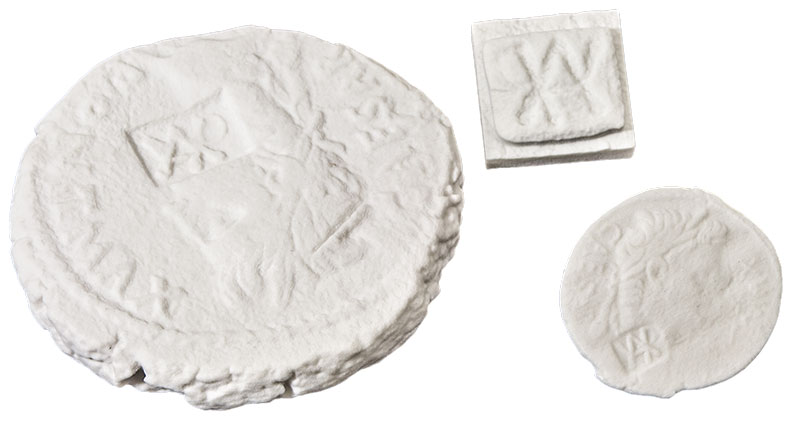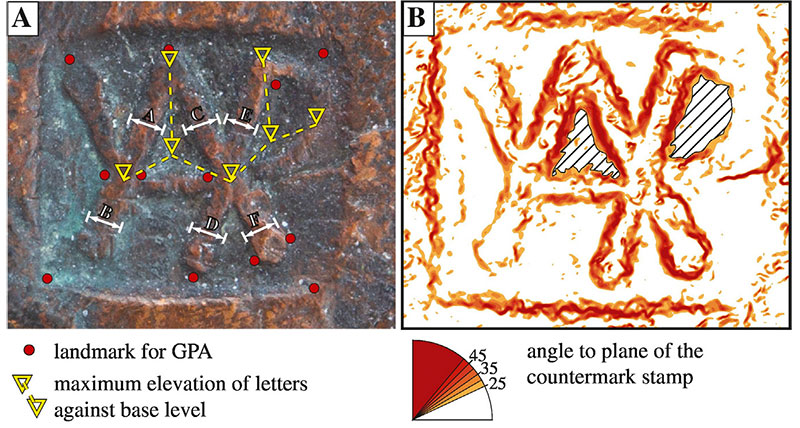3D scans of countermarks on coins to retrace Roman troop movements
Archaeological Heritage Office - Germany
Contact us

A handful of “asses” to trace historic events? The Archaeological Heritage Office of Saxony (Dresden, Germany) uses this innovative approach to study Roman copper coins (asses) to date sites of Roman troop activities between the rivers Rhine and Elbe.
Numismatic analyses of these coins are the most important tool to reconstruct the dynamics of Roman troops movements between the years 7 and 9 AD, they help to establish relations between several sites. In addition to earlier studies using manual coin measurements in a 2D reference system, the 3D data of the AICON SmartScan now help to understand these particular archaeological sites and their relations to others. Furthermore, they establish a very precise chronological framework that allows for an attribution of these sites either to a more restricted period of time or even to an individual campaign.

Objective and measuring object
This study focusses on the analysis of countermarks ascribed to Publius Quinctilius Varus, the Roman commander-in-chief and governor of the province of Germania magna from 7- 9 AD. He has become widely known for his death and the loss of three legions in the “Battle of the Teutoburg Forest”.
During his command, he distributed coins bearing a stamp with his initials “VAR” to the troops. Up to now, more than 600 copper coins with this countermark have been uncovered at Roman sites, mainly in the Rhineland area. This countermark was applied to older coins which served as small donations and only circulated on a local scale. Comprehensive studies have established the existence of different countermark dies that must have been used between 7 and 9 AD. In this specific study, 37 coins from different sites were included. Identifying individual traces and chronically ordering them by means of increasing use-wear may offer new insights into the movement of Roman troops.
Measuring system and setup
To capture even the finest details of the countermarks, the AICON SmartScan with a camera resolution of 8 Megapixels and a field of view of 75 mm is used. As the true colour recording of the texture is irrelevant for this study, blue projection light is chosen. Working with blue light LEDs at a wavelength around 460 nm reduces the effect of ambient light and reflections.

Workflow
To document coins with the counterstamp “VAR”, the 3D scanning took place in several museums. The scanning data were processed with the AICON software OptoCat. Based on the AICON SmartScan scan data, an average resolution of 29 μm was achieved for the final 3D models. To accentuate the surface conditions of the coins, greyscale shaded relief images were produced using the software TroveSketch.
Tools to compare and visualise the mesh-to-mesh distances between two 3D models are implemented in several software packages (e.g. Geomagic Studio, OptoCat) and have been applied successfully in archaeology to assess the quality of 3D scanning records. However, the tools depend on an optimal alignment between two models that does not work correctly in this study as the surfaces of countermarks are in some cases affected by later damage. Moreover, as a single reference model cannot be established, every individual model would have to be compared to all other models to identify changes in geometry. Therefore, the research group has chosen a full Procrustes analysis of the data to explore if the dies can be separated based on their individual geometry. Procrustes approaches have become increasingly popular in archaeology and have proved to be useful for identifying clusters of specimens based on their morphology. The main advantage of this approach is the robustness towards damaged countermarks as it compares the geometry of 3D landmarks instead of surface geometries.
 Detailed analyses were performed on a particular subset of coins to reveal features related to use-wear and recutting of a specific die. In a first step, all 3D models were aligned manually to a horizontal plane using Surfer. As ongoing recutting should affect the width and depth of the incised letters together with changes in the size of the raised areas inside the letters A and R, these trends were measured in the 3D models. The maximum difference in elevation between the inner areas of the letters A and R to three reference points on the projecting letter lines were recorded on 16 sufficiently preserved countermarks as indicator of incision-depth of the letters on the original die. The elevation maps were generated from the 3D models with a shared elevation colour scale starting from the lowest point of the individual imprint.
Detailed analyses were performed on a particular subset of coins to reveal features related to use-wear and recutting of a specific die. In a first step, all 3D models were aligned manually to a horizontal plane using Surfer. As ongoing recutting should affect the width and depth of the incised letters together with changes in the size of the raised areas inside the letters A and R, these trends were measured in the 3D models. The maximum difference in elevation between the inner areas of the letters A and R to three reference points on the projecting letter lines were recorded on 16 sufficiently preserved countermarks as indicator of incision-depth of the letters on the original die. The elevation maps were generated from the 3D models with a shared elevation colour scale starting from the lowest point of the individual imprint.
Result
The metrical analyses show a gradual change of both the width and height of the letters A and R together with considerable changes of the inner areas of the letters. These results are in good correspondence with the assumption that the die may have been affected by use-wear and recutting during its life cycle. Thanks to the analyses based on the detailed 3D data of the AICON SmartScan, five different use-wear phases of the die could be identified. To illustrate the differences between the counterstamps even more clearly, the 3D data were used for 3D cast prints at a scale of 8:1 and 3:1.
High resolution 3D scanning together with geometrical and metrical statistics and visual use-wear assessment is a powerful tool to establish a refined internal chronological division of countermarked Roman coins. Combining the spatial information of the archaeological sites and the subchronology of the specific countermark, the relevance of this approach will be tested by detailed future studies of Roman troop movements. As the latest countermarks are found in the Rhine area and not on the battlefield of Kalkriese (Teutoburg Forest), it seems reasonable to date the terminal use of the die to sometime before the defeat of Varus in 9 AD.
AICON 3D Systems honored this exceptional 3D scanning project with a special prize of the Bernd Breuckmann Award 2014.